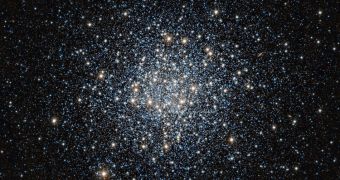Using its 4.1-meter Visible and Infrared Survey Telescope for Astronomy (VISTA), in northern Chile, the European Southern Observatory (ESO) has recently captured an amazing image of the star cluster Messier 55. This formation contains thousands of ancient stars, some of the oldest in the Universe.
Located at the Paranal Observatory, VISTA is an extremely capable instrument, which can easily survey globular clusters such as this one in high resolution. These investigations can shed more light on how galaxies appear and how they have evolved over the course of their lifetimes.
One of the main characteristics that separate globular clusters from other types of clusters is that they are held in a very precise geometric shape by intense gravitational interactions between their components.
According to ESO investigators, Messier 55 contains as many as 100,000 stars, all of them crammed up in a region of space about 25 times longer in diameter than the distance between the Sun and Alpha Centauri (about 4.3 light-years).
Previous studies have detected roughly 160 globular clusters spread throughout the Milky Way. The bulging galactic core, which is also the home of a supermassive black hole, also hosts most of these clusters, though some of them lie very close to the galaxy's rim.
At a diameter of around 100,000 light-years, the Milky Way is a medium-sized galaxy, which is dwarfed by other structures out there. Astronomers estimate that some of the largest galaxies in the Universe may contain thousands of globular clusters.
“Sky watchers can find Messier 55 in the constellation of Sagittarius. The notably large cluster appears nearly two-thirds the width of the full Moon, and is not at all difficult to see in a small telescope, even though it is located at a distance of about 17,000 light-years from Earth,” an ESO press release says.
This particular cluster is believed to be made up of extremely old stars that first appeared some 10 billion years ago. For comparison, the age of the entire Universe is currently estimated at 13.75 billion years, experts say. Stars in Messier 55 formed from the same enormous gas cloud.
“As this formative period was just a few billion years after the Big Bang, nearly all of the gas on hand was the simplest, lightest and most common in the cosmos: hydrogen, along with some helium and much smaller amounts of heavier chemical elements such as oxygen and nitrogen,” the statement adds.

 14 DAY TRIAL //
14 DAY TRIAL //